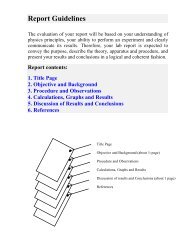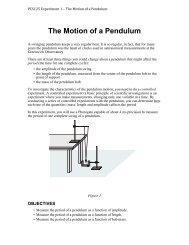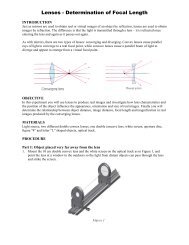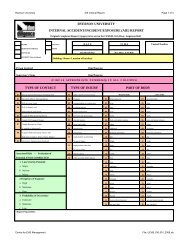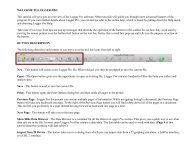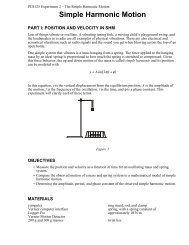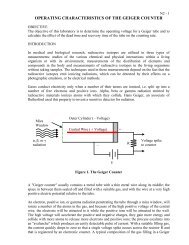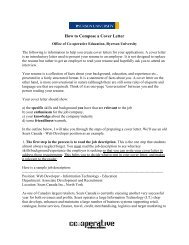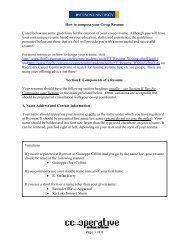Introduction to Errors and Error Analysis - Ryerson Department of ...
Introduction to Errors and Error Analysis - Ryerson Department of ...
Introduction to Errors and Error Analysis - Ryerson Department of ...
Create successful ePaper yourself
Turn your PDF publications into a flip-book with our unique Google optimized e-Paper software.
INTRODUCTION TO ERRORS AND ERROR ANALYSISTo many students <strong>and</strong> <strong>to</strong> the public in general, an error is something they have donewrong. However, in science, the word “error” means the “uncertainty” whichaccompanies every measurement. No measurement <strong>of</strong> any sort is complete without aconsideration <strong>of</strong> this inherent error. We cannot avoid the “uncertainties” by being verycareful. So how do we deal with the measurement errors? All we can do is <strong>to</strong> try <strong>to</strong>ensure they are as small as possible <strong>and</strong> <strong>to</strong> have a reliable estimate <strong>of</strong> how large they are.An important component <strong>of</strong> a science student’s education is <strong>to</strong> learn how <strong>to</strong> h<strong>and</strong>le <strong>and</strong>interpret experimental data <strong>and</strong> results. This includes the development <strong>of</strong> methodologiesneeded <strong>to</strong> estimate the errors inherent in various types <strong>of</strong> measurements, <strong>and</strong> techniquesfor testing data <strong>to</strong> find out if these error estimates are valid, <strong>and</strong> the underst<strong>and</strong>ing <strong>of</strong> theway errors propagate through calculations made using experimental data. Learning how<strong>to</strong> h<strong>and</strong>le experimental errors will be very useful also in other Sciences <strong>and</strong> Engineering.This document is a brief introduction <strong>to</strong> errors <strong>and</strong> how you approach them in the labora<strong>to</strong>ry.Please read the entire document, but do not get desperate or disappointed if you do notunderst<strong>and</strong> all the details. Different experiments deal with different aspect <strong>of</strong> errors.Mastering error analysis requires extensive practice <strong>and</strong> will not happen overnight.Consider this document as a resource on how <strong>to</strong> h<strong>and</strong>le the particular errors you face inyour lab work.1. PRECISION AND ACCURACY: TWO DIFFERENT TYPES OF ERRORSThere are two main types <strong>of</strong> errors associated with an experimental result. They arereferred <strong>to</strong> as precision <strong>and</strong> accuracy. The precision is usually related <strong>to</strong> the r<strong>and</strong>omerror distribution associated with a particular experiment or even with a particular type <strong>of</strong>experiment (for example, in the experiments where the measured parameters haveintrinsically large variations between different samples). The accuracy is related <strong>to</strong> theexistence <strong>of</strong> systematic errors, for example, the incorrect calibration.The object <strong>of</strong> a good experiment is <strong>to</strong> improve both precision <strong>and</strong> accuracy. Usually ina given experiment one <strong>of</strong> these two types <strong>of</strong> errors is dominant, <strong>and</strong> the scientistdevotes most <strong>of</strong> his or her efforts <strong>to</strong>wards reducing that one. For example, if you aremeasuring the length <strong>of</strong> a carrot in a sample <strong>of</strong> carrots <strong>to</strong> determine an average value <strong>of</strong>the length, the natural r<strong>and</strong>om variations within the sample <strong>of</strong> plants are probablygoing <strong>to</strong> be much larger than any possible measurement inaccuracy due <strong>to</strong> a badmanufacturing <strong>of</strong> the ruler that you use. In a physics labora<strong>to</strong>ry, the relative effects <strong>of</strong>the precision <strong>and</strong> accuracy on the final result usually depend on the particular experiment<strong>and</strong> the particular apparatus. Some experiments in the introduc<strong>to</strong>ry physics labora<strong>to</strong>ryhave relatively large r<strong>and</strong>om errors that require repeating measurements <strong>to</strong> increase theprecision. Other experiments are very precise, but the equipment used has built-insources <strong>of</strong> inaccuracy that cannot be eliminated.
2. THREE MAJOR SOURCES OF ERRORS2.1 READING ERRORAlmost all direct measurements involve reading a scale (ruler, caliper, s<strong>to</strong>pwatch, analogvoltmeter, etc.) or a digital display (e.g., digital multimeter or digital clock). Sources <strong>of</strong>uncertainty depend on the equipment we use. One <strong>of</strong> the unavoidable sources <strong>of</strong> errors isa reading error. Reading <strong>Error</strong> refers <strong>to</strong> the uncertainties caused by the limitations <strong>of</strong> ourmeasuring equipment <strong>and</strong>/or our own limitations at the time <strong>of</strong> measurement (for example,our reaction time while starting or s<strong>to</strong>pping a s<strong>to</strong>pwatch). This does not refer <strong>to</strong> anymistakes you may make while taking the measurements. Rather it refers <strong>to</strong> theuncertainty inherent <strong>to</strong> the instrument <strong>and</strong> your own ability <strong>to</strong> minimize thisuncertainty. A reading error affects the precision <strong>of</strong> the experiment. The uncertaintyassociated with the reading <strong>of</strong> the scale <strong>and</strong> the need <strong>to</strong> interpolate between scalemarkings is relatively easy <strong>to</strong> estimate. For example, consider the millimeter (mm)markings on a ruler scale. For a person with a normal vision it is reasonable <strong>to</strong> say thatthe length could be read <strong>to</strong> the nearest millimeter at best. Therefore, a reasonable estimate<strong>of</strong> the uncertainty in this case would be ∆l=±0.5 mm which is half <strong>of</strong> the smallestdivision. A rule <strong>of</strong> thumb for evaluating the reading error on analogue readout is <strong>to</strong> usehalf <strong>of</strong> the smallest division (in case <strong>of</strong> a meter stick with millimeter divisions it is 0.5mm), but only the observer can ultimately decide what is his/her limitation in errorevaluation. Note that it is wrong <strong>to</strong> assume that the uncertainty is always half <strong>of</strong> thesmallest division <strong>of</strong> the scale. For example, for a person with a poor vision theuncertainty while using the same ruler might be greater than one millimeter. If the scalemarkings are further apart (for example, meter stick with markings 1 cm apart), onemight reasonably decide that the length could be read <strong>to</strong> one-fifth or one-fourth <strong>of</strong> thesmallest division.There are other sources <strong>of</strong> uncertainty in direct measurements that can be much moreimportant than uncertainties in the scale or display readings. For example, in measuringthe distance between two points, the main problem may be <strong>to</strong> decide where those twopoints really are. For example, in an optics experiment it is <strong>of</strong>ten necessary <strong>to</strong> measurethe distance between the center <strong>of</strong> the lens <strong>and</strong> the position <strong>of</strong> the focused image. Buteven a thin lens is usually several millimeters thick, which makes locating the center adifficult task . In addition, the image itself may appear <strong>to</strong> be focused not at a point, butits location may span a range <strong>of</strong> several millimeters. Parallax is another significantsource <strong>of</strong> a reading error, where the reading depends on your line <strong>of</strong> sight.In the first year labora<strong>to</strong>ry you will <strong>of</strong>ten use instruments that have a digital readout. Formany digital instruments, you may assume that the reading error is ± 1/2 <strong>of</strong> the last digitdisplayed; e.g. if the reading <strong>of</strong> the timer in the free fall experiment is 682.6 ms, the errorcan be assumed <strong>to</strong> be ±0.05 ms, <strong>and</strong> you should quote (682.60±0.05) ms. Experiments onelectricity <strong>of</strong>ten employ multimeters <strong>to</strong> measure current <strong>and</strong> voltage. The usual “ ± 1/2 <strong>of</strong>the last digit” rule, which assumes an instrument that rounds <strong>of</strong>f perfectly, does notwork <strong>to</strong>o well with multimeters. Ideally, you must record the specification <strong>of</strong> themultimeter used in the experiment.. For example, a typical listing on the mutlimeter(supplied by the manufacturer) will be “accuracy ±0.75% <strong>of</strong> full scale ± 1 digit”. Thefirst percentage number is what we call the systematic error. It will affect the accuracy <strong>of</strong>2
your readings. It is an estimate <strong>of</strong> systematic differences between different scales <strong>of</strong> themultimeter. However it is the r<strong>and</strong>om error that determines the precision, <strong>and</strong> gives youan idea <strong>of</strong> the scatter that you might expect in your readings. Thus, the “± digit” quotedby the manufacturer might be a better estimate <strong>of</strong> the r<strong>and</strong>om error. Though you shouldquote the systematic error at the end <strong>of</strong> your experiment when you are comparingyour result with some “st<strong>and</strong>ard”, it is better <strong>to</strong> use ±1 digit for the r<strong>and</strong>om error in eachreading. For example, if your reading is 3.48 mA, you should quote (3.48±0.01) mA.While performing the lab, if in doubt how <strong>to</strong> record the error in a measurement usinga multimeter, consult with your TA.It is usually difficult or impossible <strong>to</strong> reduce the inherent reading error in an instrument.In some cases (usually those in which the reading error <strong>of</strong> the instrumentapproximates a “r<strong>and</strong>om error distribution”) it is possible <strong>to</strong> reduce the reading errorby repeating measurements <strong>of</strong> exactly the same quantity <strong>and</strong> averaging them.2.2 RANDOM ERRORR<strong>and</strong>om <strong>Error</strong> refers <strong>to</strong> the spread in the values <strong>of</strong> a physical quantity from onemeasurement <strong>of</strong> the quantity <strong>to</strong> the next, caused by r<strong>and</strong>om fluctuations in the measuredvalue. For example, in repeating measurements <strong>of</strong> the time taken for a ball <strong>to</strong> fall througha given height, the varying initial conditions, r<strong>and</strong>om fluctuations in air motion, thevariation <strong>of</strong> your reaction time in starting <strong>and</strong> s<strong>to</strong>pping a watch, etc., will lead <strong>to</strong> asignificant spread in the times obtained. This type <strong>of</strong> error also affects the precision <strong>of</strong>the experiment.2.2.1 Estimating Uncertainties in Repeating MeasurementsFor example, while using a s<strong>to</strong>pwatch <strong>to</strong> measure time intervals, the major uncertainty isusually not from reading the dial, but from our reaction time in starting <strong>and</strong> s<strong>to</strong>pping thewatch. The reaction time is unknown <strong>and</strong> can vary significantly from person <strong>to</strong> person<strong>and</strong> even, for the same person, from measurement <strong>to</strong> measurement. The solution is <strong>to</strong>repeat the measurement several times. Most likely you’ll obtain somewhat differentvalues for every one <strong>of</strong> your measurements. The “correct” measured value liessomewhere between the lowest value <strong>and</strong> the biggest value (the interval gives a probablerange). We assume that the best estimate <strong>of</strong> the measured value is the average value.For example, consider the sequence <strong>of</strong> four time intervals 2.3, 2.4, 2.5, 2.4 (s). Theestimate <strong>of</strong> time interval is 2.4 s (the arithmetic mean <strong>of</strong> the four individualmeasurements), <strong>and</strong> the probable range is 2.3 <strong>to</strong> 2.5 s. Note that the probable range meansthat we are reasonably confident (but not necessarily 100% certain) that the actualquantity lies within this range. Also note that the best estimate, 2.4 s, lies near themidpoint <strong>of</strong> the estimated range <strong>of</strong> probable values, 2.3 <strong>to</strong> 2.5 s. This is true in mostmeasurements.3
2.2.2 The mean x <strong>and</strong> the st<strong>and</strong>ard deviation σSuppose that we want <strong>to</strong> measure the value <strong>of</strong> a quantity, x. Let us imagine that wedo this by making a <strong>to</strong>tal number <strong>of</strong> n measurements <strong>of</strong> x, the values <strong>of</strong> eachmeasurement being denoted by x i , where i takes on the values from 1 <strong>to</strong> n. Either because<strong>of</strong> variability in the quantity x or because <strong>of</strong> inherent <strong>and</strong> unavoidable r<strong>and</strong>om errors inour measuring procedure, not all values <strong>of</strong> the individual measurements x i will be thesame. Our best estimate <strong>of</strong> the “true” value <strong>of</strong> x is then given by the average or meanvalue <strong>of</strong> x:n1x = ∑ x in 1Usually we also require some measure <strong>of</strong> the spread in the values <strong>of</strong> xi. This spreadis related <strong>to</strong> the uncertainty in our estimate <strong>of</strong> the “correct” value <strong>of</strong> x. It turns out thatthe “best” estimate <strong>of</strong> the spread is given by a quantity σ, called the st<strong>and</strong>ard deviation <strong>of</strong>x, given byσ =n 2∑ ( x − )1 ixn − 1Calculating st<strong>and</strong>ard deviations can be very tedious. You should practice such acalculation at least a couple <strong>of</strong> times by h<strong>and</strong>. Later on, for calculations <strong>of</strong> st<strong>and</strong>arddeviation, you can use a calcula<strong>to</strong>r that has a st<strong>and</strong>ard deviation function.2.2.3 The st<strong>and</strong>ard error, or the error in the mean, σmσ is associated with the error in each individual measurement xi. However, what we<strong>of</strong>ten really need <strong>to</strong> know is the error in our best estimate <strong>of</strong> x, which is the mean (best)value. Clearly this error is less than σ, the error in any individual measurement. If itweren't, we could estimate the “true” value <strong>of</strong> x as well with one measurement aswe could with many. A st<strong>and</strong>ard deviation σ <strong>of</strong> individual measurements divided by thesquare root <strong>of</strong> the <strong>to</strong>tal number <strong>of</strong> measurements is called the st<strong>and</strong>ard deviation <strong>of</strong>the mean. It is also called the st<strong>and</strong>ard error <strong>and</strong> is <strong>of</strong>ten denoted by σm. The formula( which we do not derive here) for calculating the st<strong>and</strong>ard error (the error inthe mean ) isσσm=nwhere σ is the st<strong>and</strong>ard deviation <strong>of</strong> the xi’s <strong>and</strong> n is the number <strong>of</strong> xi’s.4
Thus, our final answer <strong>to</strong> the question “what is our true measured value <strong>of</strong> x?” isx = x ± σ = x ±mσnNote that we could reduce the st<strong>and</strong>ard error by taking more measurements. Howeverthere is no point in taking more than the number required <strong>to</strong> reduce the st<strong>and</strong>ard error <strong>to</strong>below the reading error.Remember that the uncertainty in any measured quantity has the same dimensions as themeasured quantity.3. SYSTEMATIC ERRORS AND THE ROLE OFINSTRUMENT CALIBRATIONSystematic <strong>Error</strong> refers <strong>to</strong> an error which is present for every measurement <strong>of</strong> a givenquantity; it may be caused by a bias on the part <strong>of</strong> the experimenter, a miscalibrated oreven faulty measuring instrument, etc. Systematic errors affect the accuracy <strong>of</strong> theexperiment.After evaluating the reading error or the st<strong>and</strong>ard error, or both if necessary, we have <strong>to</strong>make sure that the scale <strong>of</strong> our measuring instrument is checked against an internationallyestablished measuring st<strong>and</strong>ard. Such comparison is called calibration. In the realworld, we frequently find that our measuring scale is in slight disagreement with thest<strong>and</strong>ard. For example, if you inspect such simple <strong>to</strong>ols as rulers, you will find out that notwo rulers are exactly the same. It is not uncommon <strong>to</strong> find a discrepancy <strong>of</strong> 1 mm or evenmore among meter sticks. The correct calibration <strong>of</strong> measuring instruments is obviously <strong>of</strong>great importance. However, in the first year labora<strong>to</strong>ry, the instruments you will use areusually calibrated by the labora<strong>to</strong>ry staff <strong>and</strong> ready <strong>to</strong> use (unless explicit labinstructions tell you otherwise).In addition <strong>to</strong> all the errors discussed above, there can be other sources <strong>of</strong> error that maypass unnoticed: variations in temperature, humidity or air pressure, etc. Suchdisturbances are more or less constant during our measurements (otherwise they wouldappear as r<strong>and</strong>om error when the measurement is repeated) <strong>and</strong> are generally referred <strong>to</strong> asthe systematic errors. Systematic errors are very difficult <strong>to</strong> trace since we do not knowwhere <strong>to</strong> look for them. It is important <strong>to</strong> learn <strong>to</strong> notice all the irregularities that couldbecome the sources <strong>of</strong> systematic errors during our experimental work. Moreover, it isparticularly important in data-taking always <strong>to</strong> record some information about thesurrounding physical conditions. Such information may help us later on if we discover aserious discrepancy in our experimental results. As a rule, the place, date <strong>and</strong> time <strong>of</strong>measurements, <strong>and</strong> the type <strong>and</strong> serial numbers <strong>and</strong> specifications <strong>of</strong> the instruments whichwere used must be recorded.Estimate all your reading errors while you take your data <strong>and</strong> write them down withyour data. Do the same for all manufacturers' error specifications. These usually cannotbe “guessed” later on.5
4. QUOTING THE ERRORS: ABSOLUTE AND RELATIVE UNCERTAINTIESIn general, the result <strong>of</strong> any measurement <strong>of</strong> physical quantity must include both thevalue itself (best value) <strong>and</strong> its error (uncertainty). The result is usually quoted in theformx = xbest ± ∆xwhere xbest is the best estimate <strong>of</strong> what we believe is a true value <strong>of</strong> the physical quantity<strong>and</strong> ∆x is the estimate <strong>of</strong> absolute error (uncertainty). Note that depending on the type<strong>of</strong> the experiment the prevailing error could be r<strong>and</strong>om or reading error. In case thereading error <strong>and</strong> r<strong>and</strong>om error are comparable in value, both should be taken in<strong>to</strong>account <strong>and</strong> treated as two independent errors. You will learn how <strong>to</strong> calculate ∆x in thiscase in the “ Propagation <strong>of</strong> <strong><strong>Error</strong>s</strong>” section <strong>of</strong> this document.The meaning <strong>of</strong> the uncertainty ∆x is that the true value <strong>of</strong> x probably lies between(x best −∆x) <strong>and</strong> (x best +∆x). It is certainly possible that the correct value lies slightly outsidethis range. Note that your measurement can be regarded as satisfac<strong>to</strong>ry even if theaccepted value lies slightly outside the estimated range <strong>of</strong> the measured value.∆x indicates the reliability <strong>of</strong> the measurement, but the quality <strong>of</strong> the measurement alsodepends on the value <strong>of</strong> xbest. For example, an uncertainty <strong>of</strong> 1 cm in a distance <strong>of</strong> 1 kmwould indicate an unusually precise measurement, whereas the same uncertainty <strong>of</strong> 1 cmin a distance <strong>of</strong> 10 cm would result in a crude estimate. Fractional uncertainty gives us anindication how reliable our experiment is. Fractional uncertainty is defined as ∆x/x bestwhere ∆x is the absolute uncertainty. Fractional uncertainty can be also represented inpercentile form (∆x/x )100% . bestFor example, the length l= (0.50 ± 0.01) m has afractional uncertainty <strong>of</strong> 0.01/0.5=0.02 <strong>and</strong> a percentage uncertainty <strong>of</strong> 0.02×100= 2%.Note that the fractional uncertainty is a dimensionless quantity. Fractional uncertainties<strong>of</strong> about 10% or so are usually characteristic <strong>of</strong> rather rough measurements. Fractionaluncertainties <strong>of</strong> 1 or 2% indicate fairly accurate measurements. Fractional uncertaintiesmuch less than 1% are not easy <strong>to</strong> achieve, <strong>and</strong> are rare in an introduc<strong>to</strong>ry physicslabora<strong>to</strong>ry.5. SIGNIFICANT FIGURESAn uncertainty should not be stated with <strong>to</strong>o much precision. The last significant figure inany stated answer should usually be <strong>of</strong> the same order <strong>of</strong> magnitude (in the same decimalposition) as the uncertainty. For example, the answer 92.81 s with an uncertainty <strong>of</strong> 0.3 sshould be rounded as (92.8± 0.3) s. If the uncertainty is 3 s, then the result is reported as(93± 3) s. However, the number <strong>of</strong> significant figures used in the calculation <strong>of</strong> theuncertainty should generally be kept with one more significant figure than the appropriatenumber <strong>of</strong> significant figures in order <strong>to</strong> reduce the inaccuracies introduced by rounding<strong>of</strong>f numbers. After the calculations, the final answer should be rounded <strong>of</strong>f <strong>to</strong> remove thisextra figure. You can find much more information on significant digits in a separate6
document called “Significant Figures”.6. PRACTICAL HINTSSo far, we have found two different errors that affect the precision <strong>of</strong> a directly measuredquantity: the reading error <strong>and</strong> the st<strong>and</strong>ard error. Which one is the actual error <strong>of</strong> precisionin the quantity? For practical purposes you can use the following criterion. Take onereading <strong>of</strong> the quantity <strong>to</strong> be measured, <strong>and</strong> make your best estimate <strong>of</strong> the reading error.Then repeat the measurement a few times. If the spread in the values you obtain is aboutthe same size as the reading error or less, use the reading error. If the spread in values isgreater than the reading error, take three or four more, <strong>and</strong> calculate a st<strong>and</strong>ard error <strong>and</strong>use it as the error. In cases where you have both a reading error <strong>and</strong> a st<strong>and</strong>ard error,choose the larger <strong>of</strong> the two as “the” error. Be aware that if the dominant source <strong>of</strong> erroris the reading error, taking multiple measurements will not improve the precision.7. COMMON MISTAKES AND MISCONCEPTIONS WITH ERRORS7.1 In the introduc<strong>to</strong>ry physics labora<strong>to</strong>ry, it is almost always meaningless <strong>to</strong> specifythe error <strong>to</strong> more than two significant digits; <strong>of</strong>ten one is enough. It is a mistake <strong>to</strong>write: x = (56.7 ± 0.914606) cm, or x = (56.74057 ± 0.9) cm. Instead, write: x = (56.7± 0.9) cm. You cannot increase either the accuracy or precision by extending thenumber <strong>of</strong> digits in your mean value beyond the decimal place occupied by the error.Keep in mind that the error, by its nature, denotes the uncertainty in the last one or twosignificant digits <strong>of</strong> the main number <strong>and</strong> therefore any additional digits obtained frommultiplication or division should be rounded <strong>of</strong>f at the meaningful position. So, firstcalculate your error; round it <strong>of</strong>f <strong>to</strong> one significant figure; then quote the value <strong>of</strong> yourmeasurement <strong>to</strong> the appropriate number <strong>of</strong> significant figures.7.2 When quoting errors in a result do not use the flawed logic that “my result is x, theh<strong>and</strong>book gives a value for this quantity as y, thus the error in my result is ±(x - y).”Your quoted error should be the result <strong>of</strong> your own analysis <strong>of</strong> your own experimentwhereas (x - y) relates <strong>to</strong> a comparison <strong>of</strong> your work <strong>to</strong> other people's work. (x – y)represents the difference between your result <strong>and</strong> the accepted value. Thediscrepancy can be used <strong>to</strong> characterize the consistency between different sets <strong>of</strong>measurements, but has nothing <strong>to</strong> do with the estimate <strong>of</strong> error in your ownexperiment.If a result we produce differs significantly from the accepted value, we then are obligated<strong>to</strong> explain what has produced the difference. But in quoting our own result, we mustprovide the error <strong>of</strong> our own experiment.8.1 PROPAGATION OF ERRORSIn the majority <strong>of</strong> experiments the quantity <strong>of</strong> interest is not measured directly, but mustbe calculated from other quantities. Such measurements are called indirect. As you knowby now, the quantities measured directly are not exact <strong>and</strong> have errors associated withthem. While we calculate the parameter <strong>of</strong> interest from the directly measured values, it issaid that the errors <strong>of</strong> the direct measurements propagate. This section describes how <strong>to</strong>7
∆y=calculate errors in case <strong>of</strong> indirect measurements.As an example, consider the following problem. Suppose we have measured the value <strong>of</strong>a quantity x with an uncertainty, which we denote ∆x. In order <strong>to</strong> test a theoreticalformula, suppose that we need <strong>to</strong> calculate y as function <strong>of</strong> x; i. e., y = f(x). We want <strong>to</strong>know the uncertainty in y due <strong>to</strong> the uncertainty in the value <strong>of</strong> x. This is equivalent <strong>to</strong>asking what will be the variation in y (call it ∆y) as x varies from x <strong>to</strong> (x + ∆x) ?Mathematically, this variation is given by ∆y = f(x+∆ x) - f(x). The answer comes fromthe differential calculus: if y = f(x) <strong>and</strong> ∆x is small, then∆y ≈dydx∆x=dfdx∆xThis argument can be extended for the calculation <strong>of</strong> quantities that are functions <strong>of</strong>several different measured quantities. All you will need at this point are the results thatyou can find below for different types <strong>of</strong> functions.Note that we neglect the sign in the differential, since the sign <strong>of</strong> all errors may take onnumerical values which are either + or -.For practical purposes <strong>of</strong> error calculations in our experiments you can refer <strong>to</strong> thefollowing section called “PROPAGATION OF INDEPENDENT ERRORS”. You canfind more examples in the “EXAMPLES OF ERROR CALCULATIONS” section.8.2 PROPAGATION OF INDEPENDENT ERRORSHere ∆y <strong>and</strong> the various ∆x’s are either st<strong>and</strong>ard deviations, st<strong>and</strong>ard errors or readingerrors, depending on the circumstances.Rule 1: If two mutually independent quantities are being added or subtracted:y = x 1 + x 2or y = x 1 – x 2 then∆ y=2 2( ∆x) + ( ∆x)1 2Rule 2: If two mutually independent quantities are being multiplied or divided:y = x 1 x 2 or y = x 1 /x 2 then∆yy≈∆x(x11)2∆x+ (x22)28
2 2 2 2∆y= ( a ∆x+ b ∆x)12Rule 3: If a quantity is raised <strong>to</strong> a power: y=x n<strong>and</strong> if ∆x is small then∆y≈ nxn−1∆xTherefore,∆yy≈∆xnx8.3 EXAMPLES OF ERROR CALCULATIONSExample1: If y = ax, where a is a constant,then∆y = a∆xExample 2:If y = ax 1 ± bx 2 , where a <strong>and</strong> b are constants, then∆ y ≈a2 2 2( ∆x1) + b ( ∆x2)2Example 3: If two or more mutually independent values are multiplied ordivided, (for example, y = ( x 1 x 2 )/( x 3 x 4 ), y =x 1 /(x 2 x 3 x 4 ), y = x 1 x 2 x 3 / x 4 , etc) the resultant error iscalculated as follows:∆yy≈∆x(x1∆xx1 22 23 24 2) ( ) ( ) ( )+2+∆xx3+∆xx4Example 4: If y= ln (x), then ∆y≈ ∆x/xExample 5:If y=cos (ax), then ∆ y≈a sin(ax) ∆x9. 1 DATA FITTING TECHNIQUES AND GRAPHICAL ANALYSISThe quote “A picture is worth a thous<strong>and</strong> words” is particularly true in the analysis <strong>of</strong>labora<strong>to</strong>ry data. In many experiments it is very useful <strong>to</strong> make a rough graph <strong>of</strong> the datapoints as they are being taken in order <strong>to</strong> make sure that the experimental data makesense. Carefully drawn <strong>and</strong> analyzed graphs are <strong>of</strong>ten the best way <strong>to</strong> extract the values<strong>of</strong> the unknowns <strong>and</strong> <strong>to</strong> confirm or deny the theoretical prediction being tested.Finally graphs are essential in presenting your results in a report. Straight line graphshave a special significance. Their interpretation is <strong>of</strong>ten simplest, since all straight linesplotted on an x−y graph have the formy=ax+b9
where a is the slope <strong>of</strong> the line (the tangent <strong>of</strong> the angle between the line <strong>and</strong> the x-axis),while b is the intercept on the y-axis. Usually x <strong>and</strong> y depend only on the known ormeasured quantities while a <strong>and</strong> b contain the unknowns which you are trying <strong>to</strong> find.Though a plot <strong>of</strong> your data points in their raw form will not generally lie on a straightline, you will find that data can usually be made <strong>to</strong> fit a straight line by manipulating theequation. If there are two <strong>and</strong> only two unknowns in your experiment, it is <strong>of</strong>tenpossible <strong>to</strong> put the theoretical relationship in<strong>to</strong> the form <strong>of</strong> a linear equation.You also need <strong>to</strong> show the uncertainty in each point <strong>of</strong> your graph. This is done bydrawing the so-called error bars. The error bars are the lines corresponding <strong>to</strong> the size <strong>of</strong>the error on either side <strong>of</strong> the data point. The error bars are drawn vertically for errorsin y values <strong>and</strong> horizontally for errors in x values.When you are attempting <strong>to</strong> fit a straight line <strong>to</strong> some data points by h<strong>and</strong>, draw a linethat encompasses a majority <strong>of</strong> points <strong>and</strong> passes as close <strong>to</strong> all <strong>of</strong> them as possible,taking in<strong>to</strong> account the errors (indicated by “error bars”) which indicate the uncertaintyin the position <strong>of</strong> the points. This “best” line is a graphical estimate <strong>of</strong> the “average” <strong>of</strong>the data; by seeing how far on either side <strong>of</strong> this “best” line you can draw otheracceptable lines. Note that all points need not lie on the line; remember that a scatter<strong>of</strong> points about a theoretical curve is <strong>to</strong> be expected in the real world. However,deliberately ignoring a few points without a good reason, just because they spoil aperfect fit <strong>to</strong> the other points is very bad science. Spread the data nicely across theavailable area by choosing the scales appropriately on the two axes, which may or maynot include the origin at (0,0). It is better <strong>to</strong> avoid the use <strong>of</strong> an unnatural subdivision<strong>of</strong> intervals. Use multiples <strong>of</strong> 2, 5, or 10 whenever possible (not 3 or 7).9.2 USING THE COMPUTER TO FIT GRAPHSThe computer provides an objective procedure for giving a best fit <strong>of</strong> a straight lineor a specified function (usually polynomial) <strong>to</strong> your data. The computers calculate thesquare <strong>of</strong> the distance between your data points <strong>and</strong> the curve it is trying <strong>to</strong> find. Itthen adjusts the constants <strong>of</strong> the polynomial representing the curve until the sum <strong>of</strong>these squares is a minimum. It gives you the values <strong>of</strong> the constants found from theprocedure.Although the computer has a data-plotting utility, for the majority <strong>of</strong> our first year labsyou don’t have <strong>to</strong> use the computer. At the initial stages <strong>of</strong> your lab experience you willlearn much more about your data if you plot your graphs <strong>and</strong> calculate the slopes byh<strong>and</strong> instead <strong>of</strong> using computers.REFERENCESJ.R. Taylor, An <strong>Introduction</strong> <strong>to</strong> <strong>Error</strong> <strong>Analysis</strong> (University Science Books, Mill Valley,California, 1982).10



